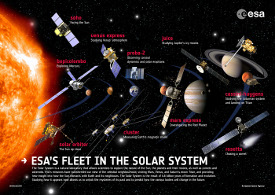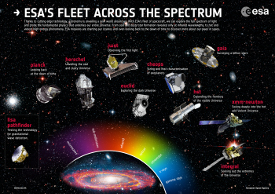Working life extensions for ESA’s science missions
20 November 2014
Continuing operations of ten space science missions have been extended by ESA’s Science Programme Committee (SPC).During its meeting at the European Space Astronomy Centre, near Madrid, on 19 November, the SPC gave the green light for the flotilla of spacecraft to continue their key scientific endeavours for at least another two years.
After a comprehensive review by the Science Programme’s advisory structure of the current operational status and likely scientific return of each mission in the future, the SPC agreed to continue funding for six ESA-led missions (Cluster, INTEGRAL, Mars Express, PROBA-2, SOHO and XMM-Newton) for the period 1 January 2015 – 31 December 2016. The committee also confirmed support for the final phase of Venus Express operations during 2015.
ESA’s remarkable Rosetta comet chaser was not on the agenda of the meeting. Although the nominal end of its mission is currently planned for December 2015, its scientific studies have only recently begun, so consideration of a possible extension into 2016 has been deferred until early 2015.
The go-ahead was also given to continue ESA’s contributions to three international collaborative missions, namely Hinode (with JAXA), and Cassini-Huygens and the Hubble Space Telescope (both with NASA).
 |
 |
| ESA's space science missions are depicted in these two posters. Credit: ESA | |
With all of these science missions continuing to deliver outstanding science, the SPC gave their preliminary support to further extensions for eight of the missions - all except Cassini-Huygens and Venus Express - during 2017-2018, subject to review in late 2016.
Cassini-Huygens will complete its mission in late 2017 when it enters the atmosphere of Saturn. Until then, it will observe the transition from spring to summer in Saturn’s northern hemisphere, study changes in the weather and surface features of Titan, and continue probing the icy jets of Enceladus and the spectacular rings. Venus Express is expected to burn up in Venus’s atmosphere during 2015, completing its intensive survey of the cloud-shrouded planet.
Mars Express will complete its high resolution imaging of the entire planet, monitor the variable weather of Mars, and shed new light on the origin of the moon Phobos during a number of close flybys.
Extensions for SOHO, PROBA-2 and Hinode will ensure that our Sun is closely watched as it reaches an unusually weak maximum of sunspot and flare activity. Meanwhile, the Cluster quartet will measure the effect of this activity nearer to home, as they visit new regions of Earth’s magnetosphere.
XMM-Newton, the Hubble Space Telescope and INTEGRAL will continue to provide complementary, multi-wavelength observations of the Universe. These will span studies of the Solar System, planet-hosting stars, exploding stars, black holes, and the evolution of galaxies.
Decisions to extend ESA space science missions are made on a rolling two-year schedule. The next two-year mission extension cycle will begin in mid-2016.


